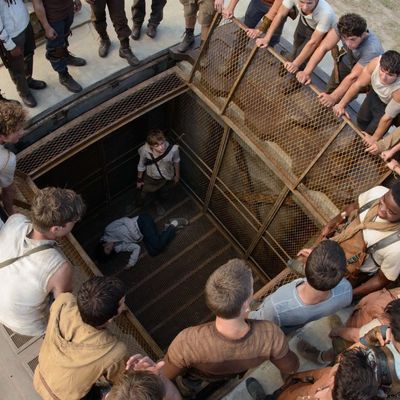
Not knowing anything about The Maze Runner — not having read the book or heard much about it — isn’t a bad way to see The Maze Runner. You experience the crazy story in real time, wondering where it’s going every step of the way, the mind uncluttered by issues of adaptation or fidelity or “world-building” or whatever. That’s probably not an option for the film’s intended audience, of course, who have all presumably read the first installment in James Dashner’s popular young adult series and know where it’s all headed. Speaking for myself, I was quite riveted.
Most of our youthful dystopias these days share common elements (some probably inspired by the challenges of high school). There are the controlled communities, often led by benevolent leaders who turn out to be not so benevolent. There’s the forced regimentation and the selection of elites. And our outlier heroes, who almost always discover that they have “special” powers, usually find themselves fighting against the complacency of those around them. This tends to stack the decks a bit: At least going by the movie versions of these stories, we spend a lot of time waiting for everybody to realize that all is not well with their societies.
But The Maze Runner dispenses with that reveal in its opening frames. Our hero Thomas (Dylan O’Brien) wakes up to find himself in a small community of young men living in a forced bucolic enclosure, and nobody seems to be under the impression that the situation is anything but fucked. Everybody’s mind has been wiped clean, and they remember nothing but their names. (“It’s the one thing they let us keep.”) Every month, their community, the Glade, gets a new member deposited via a mysterious elevator, which also delivers supplies. The Glade is surrounded by a giant, impenetrable, ever-shifting maze that opens up daily and closes at night. Some members of this community — the fastest ones — explore the maze, trying to find a way out; they just have to remember to get back before the maze’s gates close, otherwise they will be trapped inside and eaten by mysterious creatures called Grievers. If other YA movies are inspired by high school, this one seems to be inspired by prison.
That is a ridiculous setup, but it’s also a fascinating one: It’s all so artificial and elaborate that you not only wonder what it’s all for, you also wonder what sort of sick mind would even bother to create something like this. The Maze Runner wisely saves the big stuff for the end, so that for most of the movie, the immediacy of these kids’ situation takes precedence. Can they discover more of the maze? What does a Griever actually look like? Why does there seem to be something different about Thomas? Why does one of the other boys seem to recognize him, just before going crazy? And who’s the girl (Kaya Scodelario) who just got deposited via the elevator?
O’Brien, with his huge eyes and his cheekbones that could cut glass, conveys Thomas’s befuddled desperation well; he looks great when he’s totally freaked out. That’s a real talent for a young actor, since most of them are usually too busy acting stoic, hoping to land the next superhero gig. Indeed, the whole cast does an excellent job relaying the urgency of the story. These characters have pretty much no backstory; they’re defined almost exclusively by their fears. And so they all cower and hover and cluster, always watchful, never complacent. Their energy helps the film through some of its rough patches. The action scenes, for example, are shot and cut with very little coherence, but we’re still invested in the characters, so relatively little harm is done. And by the end, we’re so wound up that we may not even notice how clunky some of the bigger reveals of the film are handled. Even so, The Maze Runner only answers some of the questions it so marvelously sets up. And while I probably now know too much about the story for it to work a similar magic next time, I find myself genuinely anticipating the next one.


